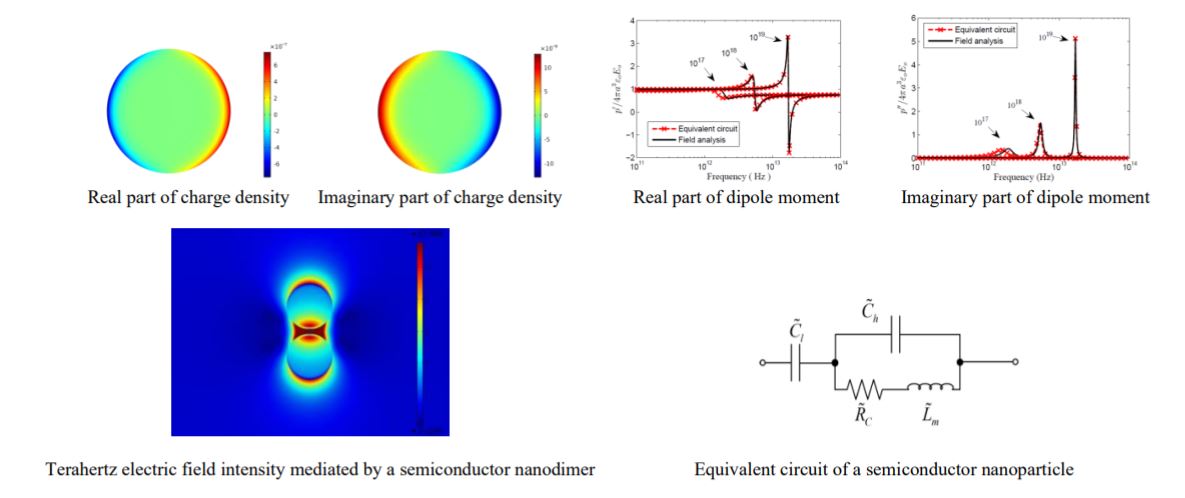Video Article Open Access
Space-Charge Interactions in Semiconductor Nanoparticles
Thomas Wong1*, Ming Yan2, Tao Shen3, Zhijing Hu2, Yanlin Li4, and Zi Wang1
1Illinois Institute of Technology, Chicago, IL 60616, USA.
2Keysight Technologies, Thousand Oaks, USA
3Kunming University of Science and Technology, Kunming, China
4Qorvo, Inc., Greensboro, USA
Vid. Proc. Adv. Mater., Volume 1, Article ID 2020-0805 (2020)
DOI: 10.5185/vpoam.2020.0805
Publication Date (Web): 05 Aug 2020
Copyright © IAAM
Graphical Abstract

Abstract
With a bulk plasma frequency in the terahertz frequency range, semiconductor nanostructures have the potential to contribute to the implementation of terahertz devices and circuit elements [1][2], in a role similar to that taken by metallic nanoparticles in the optical region [3]. Because of a lower charge carrier concentration in a semiconductor compared to that of a metal, an electric field applied to a semiconductor penetrates deeper into the bulk region so that space-charge effects become prevalent in the polarization of a semiconductor nanoparticle. To provide a realistic account of space-charge interactions in semiconductor nanoparticles, a transport formulation for charge dynamics needs to be employed [4]. By coupling the moments of the Boltzmann equation for the charge carriers to the quasi-static electric field, manifestations of space-charge effects such as field screening and plasmonic resonance can be quantitatively accounted for. In this presentation, the salient polarization phenomena displayed by semiconductor nanoparticles and nanodimers predicted by charge transport analyses and simulation are reviewed. Beginning with an exposition of charge distribution in a semiconductor nanoparticle in a static field given by the solution of the Poisson-Boltzmann equation (PBE) delineating the screening effect of space charge and its role as the low-frequency limit for the dynamic case, the merits of a charge transport formulation for analysis of dynamic polarization in a semiconductor nanoparticle is introduced. Symmetry conditions for solutions of the PBE with reference to doping effect and applied electric field intensity are discussed. The influence of the Debye length (static) and skin depth on induced current distribution in a heavily doped semiconductor nanoparticle are studied in light of the quasi-static presumption in the analysis of charge-field interactions. Evolution of plasmonic excitation as the collective response of conduction-band electrons (or valence-band holes) from surface to bulk phenomena is explained in terms of the significance in inertia effect of the charge carriers as the frequency of the polarizing electric field is increased. Extension of the basic static Debye length to the dynamic case with frequency dependence can be borne out by consideration of the complex wave number appearing in the Helmholtz equation for the charge density, which recedes to the linearized PBE in the static limit. Nanoparticles with a core-shell structure are examined for the shielding properties as well as the shift in the surface plasmon resonance frequency [5]. Field enhancement in the gap of a symmetrical semiconductor nanodimer is studied using a numerical electromagnetic simulation tool based on finite-element method. Representation of the polarizability of nanoparticles and their aggregates by generalized admittance of electrical networks and the rationale for their synthesis culminate the presentation.
Keywords
Semiconductor, nanoparticles, space charge, transport; plasmonics.
References
1. V. Giannini, A. Berrier, S. A. Maier, J. Antonio Sanchez-Gil, and J. G. Rivas, Opt. Express, 2010, 18, 2797.
2. T. Shen and T. Wong, Proc. IEEE APS International Symposium, 2011, 1613.
3. I. U. Kreibig and M. Vollmer, Optical Properties of Metal Clusters, Springer-Verlag, Berlin, 1995.
4. T. Shen, M. Yan, and T. Wong, IEEE Trans. Antennas and Propagation, 2013, 61, 4229.
5. Y. Li, Z. Hu, and T. Wong, IEEE Transactions on Nanotechnology, 2018, 17, 1029.
Biography
Thomas Wong joined the faculty of Illinois Institute of Technology in 1981 and is currently a professor. He has served as graduate program director in electrical and computer engineering, department chairman, and chair of the faculty council. His research has mainly been in applied electromagnetics, microwave instrumentation, and material characterization. He has been involved in the planning, development and mentoring in an interdisciplinary project-based learning program for two decades. He is the author of Fundamentals of Distributed Amplification (Artech, 1993), co-author of Electromagnetic Fields and Waves (Higher Education Press, 2006 & 2012), and originator of several patents in microwave electronics and wireless systems.
Video Proceedings of Advanced Materials

Upcoming Congress



